Feb 10, 2021
Research Publication
Programs Can Build on the Strengths of Latino Families with Low Incomes to Improve Outcomes
Authors:
Introduction
Healthy relationships that are positive and nurturing support children’s and parents’ well-being.1,2 Some parents have difficulty initiating and maintaining healthy relationships.3 These challenges can be compounded for families with low incomes (e.g., below 185% of the federal poverty line) that also face economic stressors.4
In 2005, Congress established the Responsible Fatherhood (RF) grant program to promote responsible parenting, economic stability, and healthy marriage. RF programs mostly serve nonresident fathers, who do not live with their children, and are intended to assist them in fulfilling their roles as parents, partners, and workers. In 2006, federally funded Healthy Marriage and Relationship Education (HMRE) programs were launched to help individuals improve their relationship skills and their paths toward economic stability and mobility. Both HMRE and RF programs have a shared goal of supporting strong and healthy family relationships in families with low incomes by building co-parent and parent-child relationships skills and promoting economic self-sufficiency.5,6,7
HMRE and RF programs serve parents of all racial and ethnic backgrounds whose children range in ages from infancy to adolescence.1 In 2018, Latinoa families made up 27 percent of the families below the official federal poverty threshold,8 yet many HMRE and RF programs are not explicitly designed to serve Latino families.5 Most RF programs are designed for nonresident fathers, but most Latino fathers live with their children and partners and already have daily involvement with their families.9 This misalignment has implications for how programming approaches can improve parent-child relationships among Latino and co-residential families. Similarly, HMRE programs are meant to improve relationships between parents and children, but many Latino parents report relatively positive relationships.10,11 To effectively tailor their approaches and strategies to the specific characteristics and dynamics of Latino families, programs should know more about eligible Latino participants’ relationships as couples and co-parents, their relationships with their children, and their financial self-sufficiency—the three foci of HMRE and RF programs.
In this brief we use data from the Early Childhood Longitudinal Study-Birth Cohort (ECLS-B) , focusing on low-income Latino children and their parents, to examine: (1) couple (i.e., couple satisfaction) and co-parenting (i.e., co-parenting conflict) relationships, (2) parenting (i.e., literacy activities, discipline, mealtime routine, mother-child relationship, and the provision of learning materials); and (3) self-sufficiency (i.e., education, household income, and employment). The data on parenting, co-parenting, and couple relationship quality used for this brief are based on mothers’ reports of their own and their partners’ behaviors. We focus on the early childhood years (infancy to kindergarten) because this period is critical for development and poses heightened demands on parents’ time and resources.12,13 And because the early years of children’s lives vary widely among parents in terms of co-parenting and parenting relationships—as well as self-sufficiency—we explore how these domains vary for parents when their children are infants (9 months), toddlers (24 months), preschoolers (48 months), and in or approaching kindergarten (60 months).
Key findings
Overall, Latina mothers reported high levels of partner satisfaction and low levels of conflict across their children’s early years. Compared to older Latino children, Latino infants are less likely to be read to by their parents or other family members but are more likely to participate in family mealtime routines. Older Latino children are also more likely to be told stories by members of their families.
Couple relationship quality is generally high among low-income Latino families, especially for parents of younger children.
- Most mothers of Latino children residing with a romantic partner reported being “very happy” with their partners/spouses, across their children’s early years.
- More Latina mothers reported being very happy when their children were preschoolers than when they were kindergartners.
Co-parenting conflicts are relatively rare among low-income Latino families, especially for parents of infants.
- Regardless of their children’s age, most mothers reported low levels of co-parenting conflict.
- More Latina mothers reported never arguing with their partners when their children were infants than when they were toddlers.
Parents in low-income Latino families read more often to older children and sing more to infants.
- Approximately one third of Latina mothers reported that a parent or another family member read to their infants often (three or more times a week), and more than half reported that someone in their family read to their children three or more times a week when they got older.
- Latina mothers reported that their children were read to more often when they were older (24, 48, and 60 months) than when they were infants, but infants were sung to more often than older (48 and 60 months) children.
Economic self-sufficiency increases among low-income Latino families as children age.
- Most fathers were employed full-time (35 hours per week or more) across their children’s early childhood years.
- A larger percentage of fathers were employed full-time when their children were older (48 and 60 months) than when they were infants.
- Approximately two thirds of low-income Latina mothers were either unemployed or not in the labor force when their children were infants. As their children got older (48 and 60 months), the percentage who were unemployed or not in the labor force decreased.
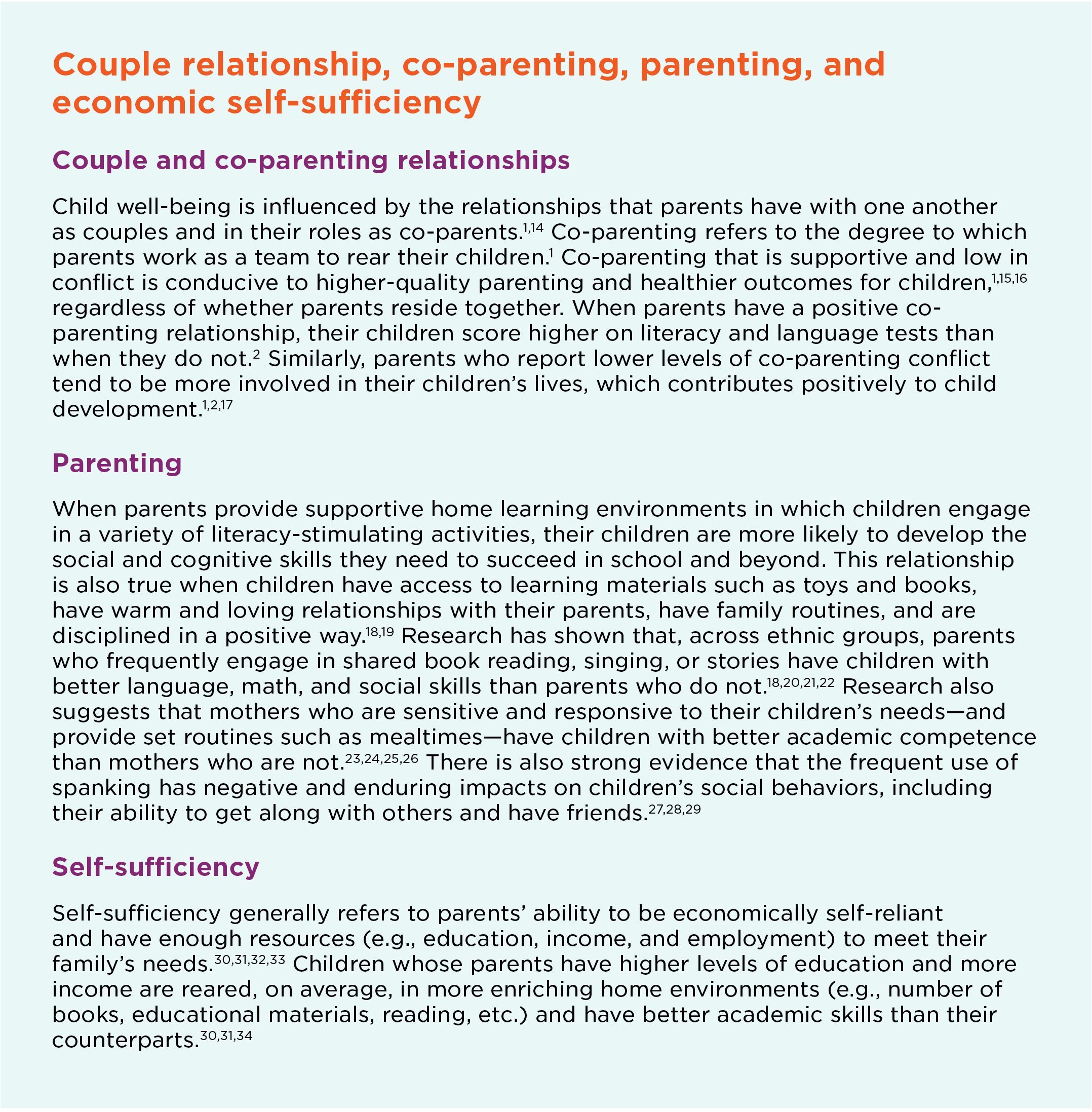
Data and Measures
Data and sample
We used data from the Early Childhood Longitudinal Study-Birth Cohort (ECLS-B), a large-scale study that followed a nationally representative sample of 10,700 children born in 2001 from birth to kindergarten. The study collected four rounds of data when children were infants (9 months), toddlers (24 months), preschoolers (48 months), and in or approaching kindergarten (60 months).b
Data for the analysis in this brief come from the 9-, 24-, 48-, and 60-month parent interviews and videotape observations of mothers and their children interacting in structured play when children were 24- and 48-months-old. In 99 percent of the cases, the parent responding to the survey was the child’s biological mother. Although the ECLS-B surveyed children’s fathers, we did not use father-reported data because of missing data on many of our variables of interest.
Our sample for this analysis is limited to children whose mothers identified them as Hispanic/Latino and who lived in low-income households. All mothers and fathers in our sample identified themselves as Latino/a or Hispanic at the 9-month interview. Most Latina mothers (74%) reported that they lived with the biological father of their child, 24 percent reported that the biological father was nonresident, and 1 percent of mothers reported living with another man (stepfather, mother’s partner, and other father type).
We defined low-income as 185 percent (or below) of the federal poverty threshold to cast a wider net of families potentially receiving assistance from federal programs such as the Supplemental Nutrition Assistance Program (SNAP), Early Head Start, and Head Start. In 2001, a household with four members and a household income that was lower than $32,652 would be classified as 185 percent of the federal poverty threshold. In our sample, the median household size is five and the median income is $20,000-25,000, with 67 percent of households reporting incomes below $30,000.c For the purposes of this study, low-income status is defined at the 9-month interview with the mother. We also limited our sample to children whose mothers were interviewed at all four rounds of data collection. Only 15 percent of infants lived in households with reported incomes of $10,000 or less per year (Table 6).d
Our final analytical sample included a total of 950 children (sample size rounded to the nearest 50). Boys and girls were equally represented in the sample. Information about parental relationships and co-parenting were reported by mothers who were married or were living with the child’s biological father (about 74%). Therefore, information about co-parenting and couple relationship is based on a sample of approximately 750 children whose mothers completed the parent self-administered questionnaire (sample size rounded to the nearest 50; Table 2).
Measures
Parental relationships. Couple relationship quality is assessed through measures of marital relationship satisfaction or disagreement. Mothers were asked, “Would you say that your marriage/relationship is … very happy, fairly happy, or not too happy?” Co-parenting conflict was assessed by asking mothers how often they and their spouse/partner have arguments about their child(ren). Data from these measures were collected at each point in time (Table 2).
Parenting is assessed through reports from mothers collected at each survey wave, and included questions on (1) parent literacy activities (i.e., singing, storytelling, and reading); (2) discipline strategies (spanking and time out); (3) mealtime routines; and (4) provision of learning materials. Mother-child relationship quality was assessed through structured observations. At 9 months, mother-child relationship quality was observed and coded with the Nursing Child Assessment Teaching Scale.35 We used the total parent score, which indicates the level of positive and responsive maternal interactions. At 24 and 48 months, mother-child relationship quality was observed and coded using the Two Bags Task,36 where parents were videotaped playing with their children using a bag with toys and a bag with a book. We included four numerical scores to assess different dimensions of maternal quality: emotional support (e.g., warmth, responsiveness), intrusiveness (e.g., physical or verbal control during the interaction), cognitive stimulation (e.g., labeling objects, verbal instruction), and detachment (e.g., emotionally uninvolved, ignoring bids for attention), based on observational data (Table 3).
Self-sufficiency is assessed through measures of household income, maternal and paternal employment, food insecurity, and use of financial assistance. Mothers were asked about their annual household income from all sources, and the highest level of education that she and her spouse/partner had received. Mothers also answered a series of questions about their current employment status and that of their spouse/partner (employed full-time, employed part-time, or unemployed or not in the labor force). Mothers were also asked about food insecurity (e.g., their worry about food running out or food not lasting) and financial assistance (e.g., whether, at any one point since their child was born, they or anyone else in their family had received food stamps, Medicaid, etc.; Table 4).
Analytic approach
We first ran descriptive statistics (mean, standard deviation) on all variables to assess the quality and frequency of couple and co-parenting, parenting relationships, and self-sufficiency when children were 9, 24, 48, and 60 months of age. Our analyses are longitudinal; that is, we used data that were collected on the same child at 9, 24, 48, and 60 months. We then ran several statistical tests to determine whether mothers’ reports of couple and co-parenting relationships, parenting relationships, and self-sufficiency changed over time (e.g., by child age at 9 vs. 24 months; 9 vs. 48 months; 9 vs. 60 months, etc.). To test whether differences between categorical variables (e.g., frequency of reading) were significant at different ages, we used the Stuart-Maxwell Test, an omnibus hypothesis test that produces a p-value for categorical variables using paired data.37,38 This test indicates whether the marginal percentages are significantly different for children at one age versus another.
To test whether differences between dichotomous response options (e.g., yes or no in response to receipt of financial assistance) were significant, we used the McNemar Tests of Marginal Homogeneity.39 The McNemar test is a statistical test used for paired dichotomous data to determine the statistical probability that the row and column marginal frequencies in a 2 x 2 contingency table are equal. We also used the McNemar’s test to assess significant differences in categorical responses between two groups within variables across points in time (e.g., the percentages of 9-month old vs. 60-month old children whose mothers had less than a high school diploma). To test for mean differences between continuous variables, we used paired samples t-tests. All age group differences noted in the text are statistically significant at the p <.05 level.
All analyses were weighted to adjust for differential nonresponse at the 60-month (kindergarten) age, attrition over time, and the initial probabilities of selection into the ECLS-B sample. The findings apply to the general population of low-income Latino children born in 2001 when they were 9, 24, 48, and 60 months. The analysis weight W4R0 is positive when there is a completed parent interview at each of the four data collection waves. Our findings cannot be generalized to the full population of 24-, 48-, and 60-month-old children, but only to Hispanic, low-income children of these ages who were born in the United States in 2001. Thus, when reporting age differences, we are comparing the cohort of children born in the United States in 2001 when they reached the ages of 24, 48, and 60 months.
Limitations
This analysis had several limitations. Children participating in the ECLS-B were born in the United States in 2001, so this analysis may not necessarily reflect the infants and toddlers born today. We only use data reported by children’s mothers when measuring our key variables. We could not include fathers’ reports of their own behaviors because of the high percentage of missing data. Moreover, some variables (e.g., family’s receipt of financial assistance) were only asked in the parent interview, which in nearly all cases was answered by the mother. Additionally, father-child relationship quality was not included in the ECLS-B dataset. Thus, we only include children’s mothers’ perspectives on co-parenting, parenting relationships, and self-sufficiency. There are also limitations with the assessments of couple relationships because children’s mothers were only asked these questions if they were married and/or living with their romantic partner. In addition, these questions were not included in the parent interview, but were asked in the parent Self-Administered Questionnaire (SAQ). There were slightly more missing data on the SAQ than for the parent interviews administered using a computer-assisted personal interviewing (CAPI) instrument; however, these missing data were still relatively low.
Findings
Couple and co-parenting relationships
As noted above, questions on couple relationship quality and co-parenting were only asked of mothers who were residing with a romantic partner (who may or may not be the biological father of the child) at the time of the interview. However, in this subsample of the ECLS-B, 75 percent of fathers living with their children were biological.
Couple relationship
As shown in Table 2, almost all (95%) low-income Latino infants’ mothers reported being either very happy or fairly happy in their relationship with their spouses or partners. This continued to be the case when children were 24, 48, and 60 months (97%, 98%, and 99%, respectively). The percentage of mothers who reported being unhappy (5%) was higher for mothers of infants than for mothers of kindergartners.
Co-parenting conflict
In general, few Latina mothers (9%, 23%, and 10% at 9, 24, and 48 months, respectively) reported that they often argued with their spouse/partner about their children (i.e., co-parenting conflict) during their children’s early years. However, mothers’ reports of arguing often about childrearing increased as their children got older. Children’s mothers were more likely to report co-parenting conflict when their children were toddlers (23%) than when they were infants (9%; Table 2).
Parenting behaviors among low-income Latino families
Literacy activities
Overall, Latino parents engaged in several types of literacy activities with their children, including reading, singing, or telling stories; however, involvement in these activities varied by children’s age. Family members were more likely to read and tell stories to their children when the children were older (48 and 60 months) than when they were infants (Table 3). Almost all parents sang to their infants, but the frequency with which parents sang to children decreased as children got older (48 and 60 months).
Reading
More than one third of infants (35%) had a parent or family member read to them at least three times each week; more than half (51%) were read to one to two times a week and approximately one fifth (21%) never had a parent or family member read to them (Table 3). More than half of children ages 24 to 60 months had a parent or other family member read to them at least three times per week (51% at 24 months, 52% at 48 months, and 60% at 60 months). More children were read to three or more times a week when they were kindergartners (60 months) than when they were infants.
Singing songs
A large percentage of children (82%) had a parent or other family member who sang to them three or more times a week when they were infants (Table 3). Over time, the percentage of children whose parent or family member sang to them three or more times a week declined from 79 percent at 24 months to 58 percent at 60 months. At each age, less than 10 percent of children’s parents or family members never sang to them.
Telling stories
According to their mothers, roughly one third of infants (34%) and less than half (41%) of older children (24, 48, and 60 months) were told a story often—that is, three or more times a week (Table 3). Latina mothers reported that their children were less likely to often hear a story often when they were infants (29%) than when they were older. The percentages of children at 24, 48, and 60 months who were less likely to often hear a story were 48, 41, and 46 percent, respectively. The percentage of Latino children who were never told a story declined from 39 percent at 9 months to 9 percent at 60 months.
Discipline
Spanking
Most children’s mothers reported never spanking their children at any age (64% of toddlers, 72% of preschoolers, and 78% of kindergartners; Table 3). Roughly 30 percent of mothers reported spanking their toddlers or preschoolers one to three times in the past week. Only 5 percent of children’s mothers spanked them more than three times in the past week when they were toddlers (Table 3). More children were spanked one to three times in the past week when they were toddlers (31%) than when they were preschoolers (27%) or kindergartners (21%).
Time-out
Approximately 30 percent of Latino children’s mothers reported putting their toddlers in time-out or sending them to their rooms one to three times in the past week; another 10 percent reported disciplining their toddlers this way three or more times in the past week. More mothers reported putting their children in time-out or sending them to their rooms one to two times in the past week when their children were preschoolers or kindergartners (54%) than when they were toddlers (31%; see Table 3).
Mealtime routines
The majority of Latino children’s mothers reported that their family ate meals together three or more times per week. This pattern persisted across children’s early years and ranged from 87 percent at 24 months to 82 percent at 60 months. More children shared a meal with their families when they were toddlers than when they were preschoolers or kindergartners (Table 3).
Mother-child relationship quality
ECLS-B staff observed that Latina mothers who live in low-income households spend moderate-quality time with their children during a semi-structured play interaction (Table 3). When children were infants, their mothers were observed to be moderately engaged with them during play. On average, when they were toddlers and preschoolers, their mothers were observed to be moderately supportive and displayed low levels of negative parenting behaviors such as intrusiveness. Latina mothers were observed to be more emotionally supportive and to provide more cognitive stimulation to their preschoolers than to their toddlers. However, these differences were very small.
Provision of learning materials
Across children’s early years, low-income Latina mothers reported that, on average, their children had a variety of learning materials such as children’s books, recordings, tapes, and CDs (Table 3). On average, mothers reported that their toddlers had 20 children’s books and had access to more books when they were older (25 books at 48 months and 31 books at 60 months).
Self-sufficiency
Education
With some small differences, low-income Latino children’s mothers and fathers had similar levels of educational attainment across the children’s early years (Table 4). From the time that children were 9 months old, through 60 months, 43 to 47 percent of mothers and 51 to 55 percent of fathers had less than a high school education; 27 to 35 percent of mothers and fathers had a high school education. Additionally, 3 to 5 percent of children had mothers and fathers who had earned a Bachelor’s degree or higher. Only one change was statistically significant: More Latina mothers and fathers had less than a high school diploma when their children were infants (47% for mothers and 51% for fathers) than when their children were older (43% at 60 months for mothers and 55% at 24 months for fathers).
Across children’s early years, 16 to 20 percent of children had mothers with a vocational degree or some college, and 12 to 17 percent of children had fathers with the same credentials.
Employment
In terms of maternal employment, 40 to 50 percent of children’s mothers were not in the labor force at any of the four ages examined (Table 6). Less than one quarter (24%) of low-income Latino children’s mothers worked full-time (>35 hours) when their children were infants, compared to more than one third of mothers of preschoolers and kindergartners (36% and 37%, respectively).
In terms of paternal employment, a large majority of children had fathers who were working full-time when they were infants (81%).
Income
In 2001, the majority of infants lived in households with reported incomes of $10,001 to $30,000 per year (67%; Table 6).e Only 15 percent of infants lived in households with reported incomes of $10,000 or less per year (Table 6). Compared to infants, a higher percentage of older children (27% at 24 months, 33% at 48 months, and 35% at 60 months) lived in households with incomes greater than $30,000.
Other indicators of self-sufficiency
Other indicators of children’s families’ self-sufficiency—including food security (i.e., access to enough, safe, and nutritious food) and receipt of social services such as Medicaid and welfare—remained relatively consistent across the first five years of children’s lives (Table 4). For example, the percentage of children whose mothers reported living with their children in a food-secure home ranged from 77 percent among infants to 84 percent among toddlers. A higher percentage of Latina mothers reported feeling food-secure when their children were older (84% at 24 months and 80% at 60 months) than when they were infants.
The percentage of children whose families received food stamps ranged from 26 percent among infants to 33 percent among kindergartners. More Latina mothers reported using food stamps when their children were older (28% at 48 months and 29% at 60 months) than when they were infants.
Summary and Implications
This brief describes three aspects of family life among low-income Latino families that are the foci of HMRE programming efforts: (1) the couple and co-parent relationship, (2) the parenting relationship, and (3) self-sufficiency. Below, we summarize the main findings for low-income Latino parents across these domains and highlight important implications for programs seeking to serve Latino families.
Couple and co-parenting relationships
Our findings show that most low-income Latina mothers who were living with a romantic partner reported being fairly happy or very happy with their partners/spouses. Only a small percentage of mothers reported some relationship dissatisfaction. Similarly, low-income Latino children’s mothers reported relatively low levels of co-parenting conflict, with some peaks during the toddler years. These findings suggest that most Latino children live in harmonious families in which conflict is rare.
Future research should explore how programs targeting low-income Latino parents adjust their curricula to meet the needs of Latino families, who are generally well-functioning (based on our findings). How might programs build on these strong foundations? How do programs offer support to maintain these relationships and provide Latino families with skills to navigate difficult times related to poverty or the changing needs of children as they age?
Parenting
Our findings show that low-income Latino mothers were moderately supportive in engaging with their children during parent-child interactions, and that parents provided their young children with a variety of learning and educational opportunities at home. Although children were read to less frequently when they were infants than when they were preschoolers, most were exposed to several types of cognitive stimulation, including singing and storytelling by a parent or other family member. We could not determine, however, the quality of these literacy activities. We know that parents’ level of education is generally associated with the quality of literacy activities (such as asking more who/what/why/where/when questions), and the majority of parents in our sample had less than a high school diploma.30,31 This may impact the quality of parents’ literacy activities with children.
Programs and policies should acknowledge the literacy activities that parents already provide to their children and then tailor programs—first, to increase the frequency with which parents or family members read to infants, and then to bolster the quality of literacy activities. Parents, (especially fathers) across all ethnic and racial groups are less likely to read to infants on the belief that they are too young to benefit.40,41 Programs should address this belief and encourage parents to read to all children. Rather than focus on the frequency of reading alone, programs can adjust their curricula to offer parents specific guidance on engaging in high-quality shared-book reading (dialogic reading) with all their children.42,43 This type of reading includes asking questions of the child, labeling new words and concepts, and making the child excited about the book, and is more likely to raise interest in reading among young children and increase their vocabulary skills.43
Additionally, most low-income Latino mothers reported never spanking their toddlers or preschoolers. However, one third reported spanking their one to three times per week, on average. This level of spanking is concerning and may be an area for programs to address. Low-income Latino mothers in our sample seemed to use time-outs more frequently than spanking; time-outs as a form of discipline were used more often when disciplining older children. These findings are consistent with national studies finding that the use of physical discipline decreases and is replaced with other forms of punishment as children grow from toddlers to preschoolers.44
Programs that offer parenting programs should incorporate these findings and acknowledge and support low-income Latino parents’ choice to not spank their children, while also offering alternative discipline strategies.
Self-sufficiency
Finally, our findings suggest that most Latino fathers and half of Latino mothers were working but had relatively low levels of education (less than a high school diploma), a pattern that persisted over the early years of their children’s lives. Even though the characteristics of our sample were measured in the early- to mid-2000s, these figures are relatively similar to those reported for contemporary Latino families. For example, an analysis of data from the first wave of the 2014 Survey of Income and Program Participation, conducted by the U.S. Census Bureau, found similar patterns as our analysis.45
Programs that serve low-income Latino families should emphasize training and education services so parents can build human capital and obtain better-paying jobs. Higher incomes and increased education are important ways (although not the only ways) to improve the quality of the home environment—including the parent-child interaction and the quality of the cognitively stimulating practices that parents already engage in with their children—while also promoting economic mobility.
Conclusion
Our findings indicate that, despite experiencing economic hardship, low-income Latino families with young children who are eligible for federal programs such as HMRE and RF rear their children in their early years in relatively positive and supportive environments. The fact that most low-income Latino children live with both of their biological parents represents a significant strength of these families. Their home environment is characterized by happy relationships between parents and by low levels of conflict in the co-parenting relationship, both of which are likely to benefit children’s development and growth. In these homes, children are exposed to a range of cognitively stimulating activities frequently enough to make a difference in their development of cognitive skills, especially for older children, and are exposed to structured environments that offer them access to a range of educational learning materials. However, infants in low-income Latino families may be less cognitively stimulated than older children, offering an opportunity for targeted interventions. Our findings suggest that programs can build on Latino families’ strengths to provide continued and targeted support that helps these families and children succeed.
Tables
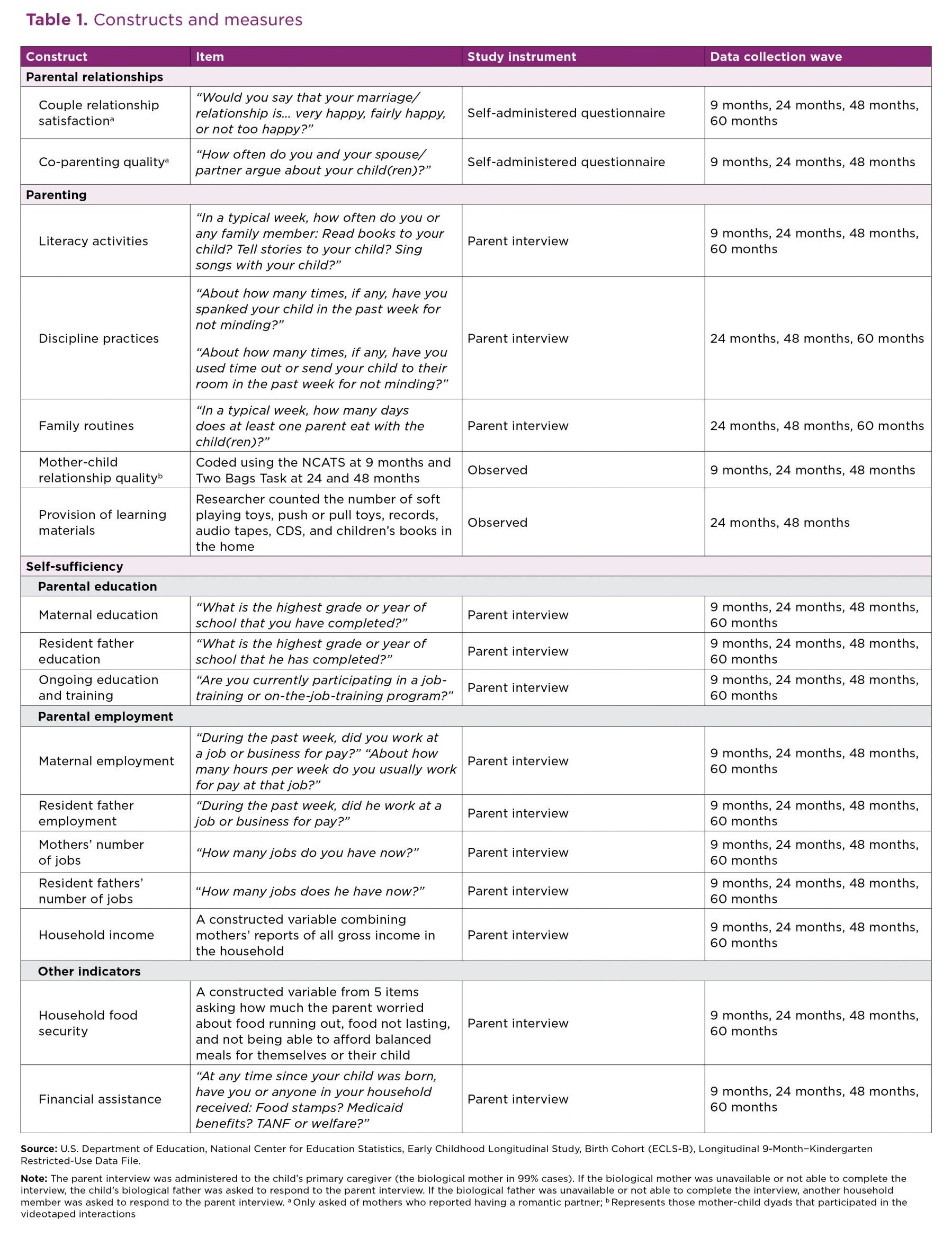
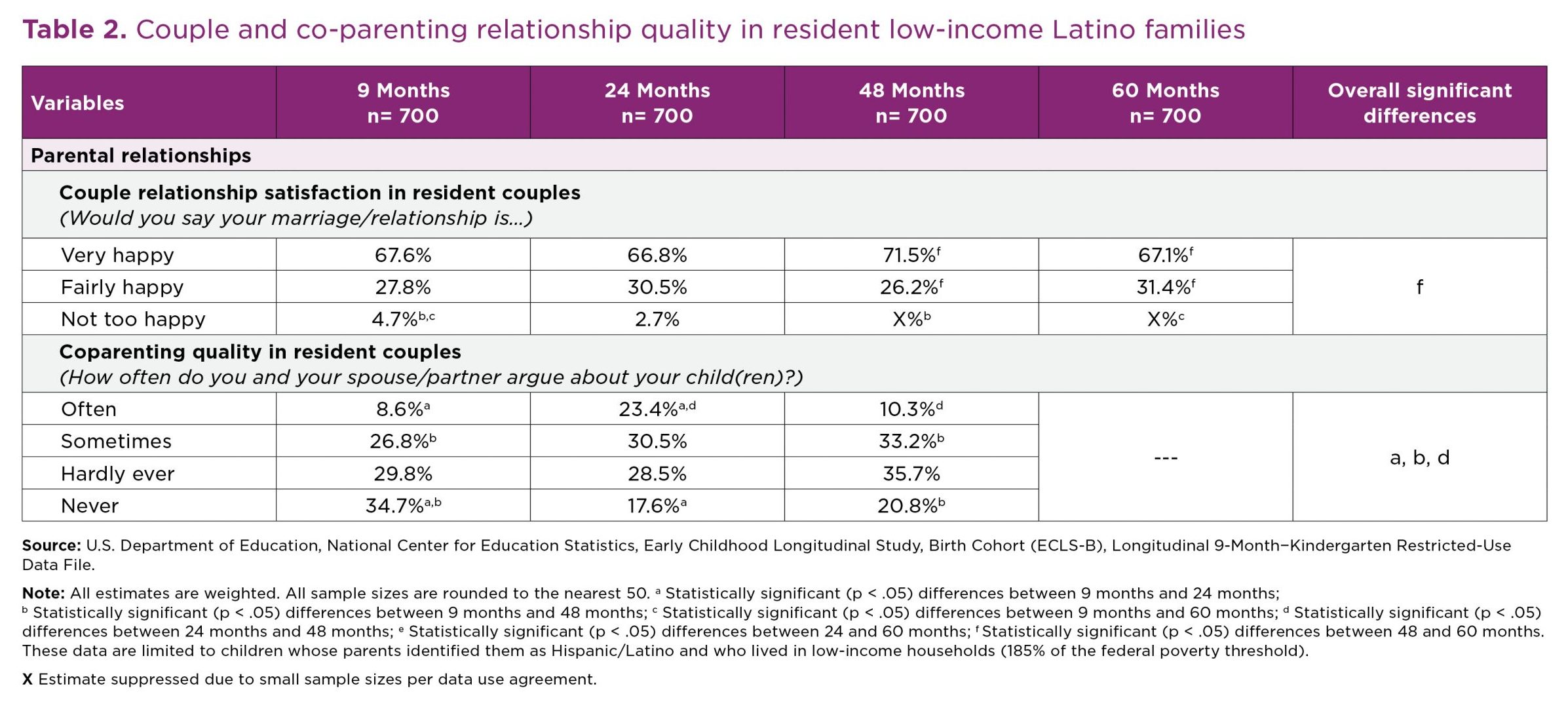
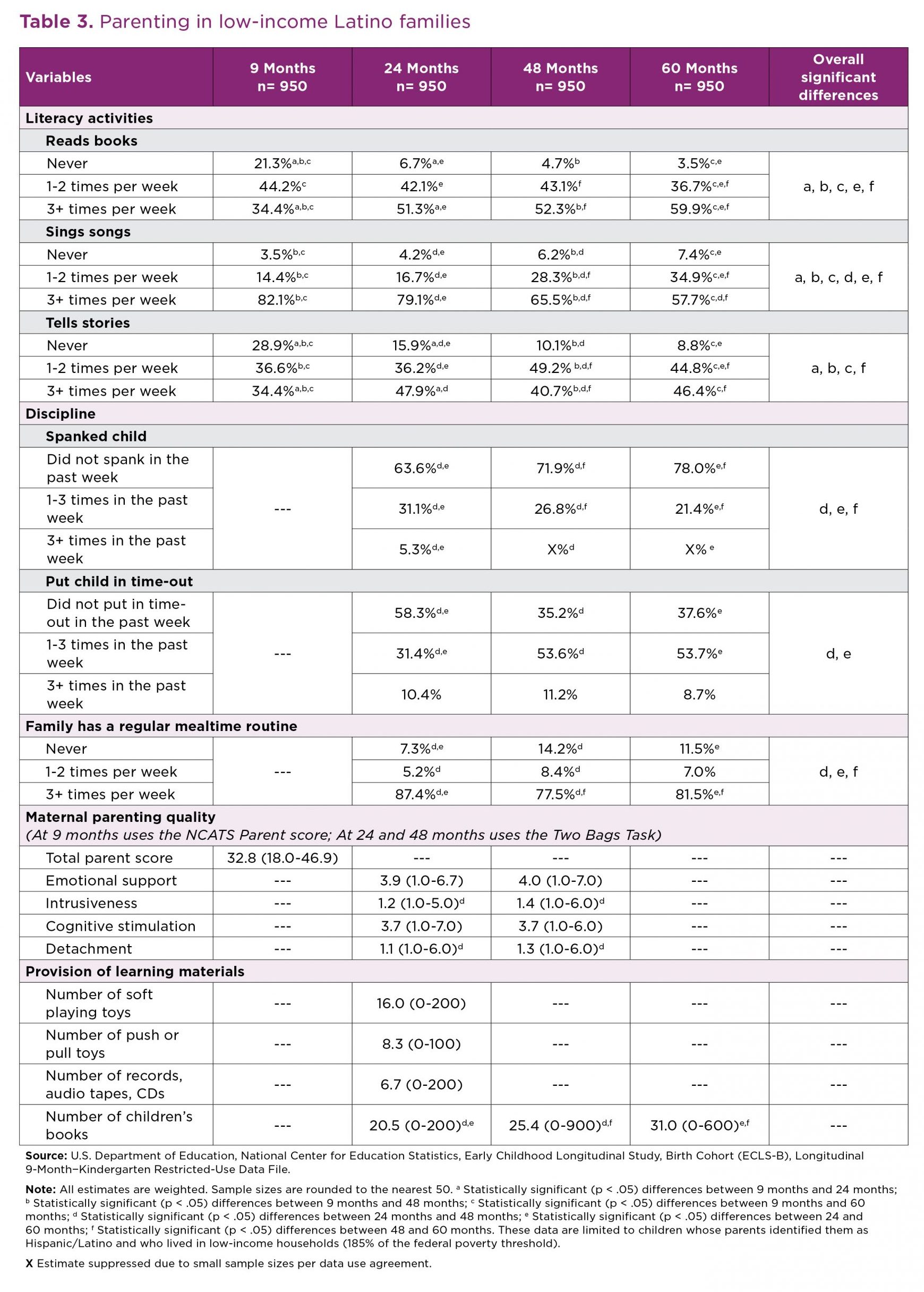
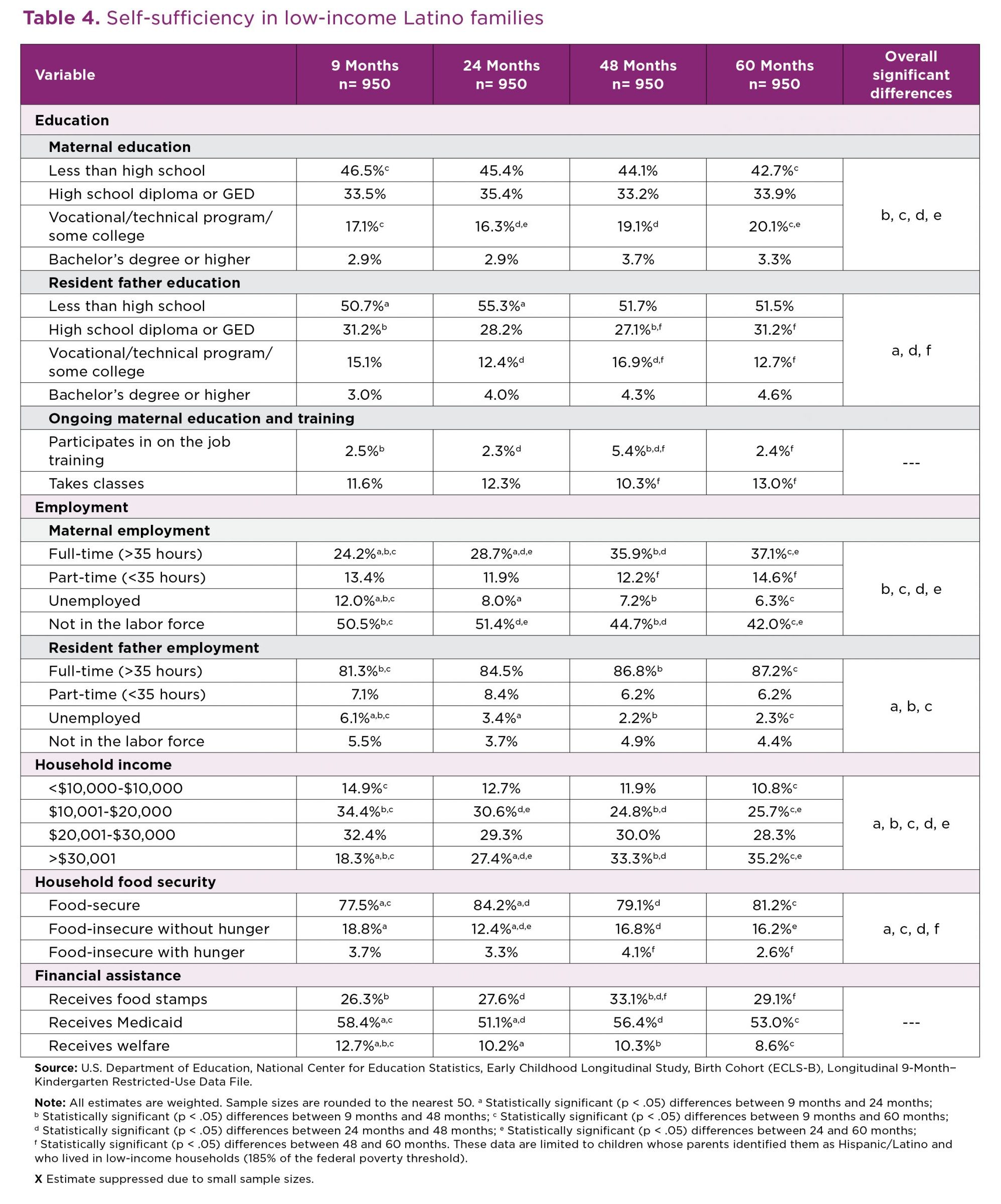
Footnotes
a We use the terms “Hispanic” and “Latino” interchangeably.
b A fifth round of data was collected for those children not enrolled in kindergarten at the time of the 60-month round.
c Adjusted for inflation, $30,000.00 in 2001 is equal to $43,699.00. Annual inflation over this period was approximately 2 percent.
d Adjusted for inflation, $10,000.00 in 2001 is equal to $14,768.62 in 2020. Annual inflation over this period was approximately 2 percent.
e Adjusted for inflation, $10,000.00 in 2001 is equal to $14,768.62 and $30,000.00 is equal to $43,699.00 in 2020. Annual inflation over this period was 2.07 percent and 2.85 percent, respectively.
Suggested Citation
Cabrera, N., Hennigar, A., Chen, Y., West, J., Fagan, J., & Wildsmith, E. (2021). Programs Can Build on the Strengths of Latino Families with Low Incomes to Improve Outcomes. Report 2021-02. Bethesda, MD: National Research Center on Hispanic Children & Families. Retrieved from www.hispanicresearchcenter.org/research-resources/programs-can-build-on-the-strengths-of-latino-families-with-low-incomes-to-improve-outcomes.
References
1 Cabrera, N. J., Shannon, J. D., & La Taillade, J. J. (2009). Predictors of coparenting in Mexican American families and links to parenting and child social emotional development. Infant Mental Health Journal, 30, 523-548. doi: 10.1002/imhj.20227
2 Cabrera, N., Scott, M., Fagan, J., Steward-Streng, N., & Chien, N. (2012). Coparenting and children’s school readiness: A mediational model. Family Process, 51(3), 304-321. doi: 10.1111/j.1545-5300.2012.01408.x
3 Ooms, T., & Wilson, P. (2004). The challenges of offering relationship and marriage education to low-Income populations. Family Relations, 53(5), 440-447. doi: 10.1111/j.0197-6664.2004.00052.x
4 Trail, T. E., & Karney, B. R. (2012). What’s (not) wrong with low‐income marriages. Journal of Marriage and Family, 74, 413-427. doi: 10.1111/j.1741-3737.2012.00977.x
5 Scott, M. E., Hickman, S., Brown, E., & Faccio, B. (2015). A guide to Healthy Marriage and Responsible Fatherhood programs for Hispanic couples and families. Report 2015-16. Bethesda, MD: National Research Center on Hispanic Children & Families. Retrieved from https://www.childtrends.org/publications/healthy-marriage-and-responsible-fatherhood-programs-for-hispanic-couples-and-families-a-program-guide
6 Cowan, P. A., Cowan, C. P., & Knox, V. (2010). Marriage and fatherhood programs. The Future of Children, 20, 205-230. doi:10.1353/foc.2010.0000
7 Holcomb, P., Zaveri, H., Friend, D., Dion, R., Baumgartner, S., Clary, L., D’Angelo, A., & Avellar, S. (2019). Supporting the fatherhood journey: Findings from the Parents and Children Together Evaluation (PACT). OPRE Report #2019-50. Washington, D.C.: Office of Planning, Research, and Evaluation, Administration for Children and Families, U.S. Department of Health and Human Services. Retrieved from https://devd8.acf.hhs.gov/opre/report/supporting-fatherhood-journey-findings-parents-and-children-together-evaluation-pact
8 Kaiser Family Foundation. (2018). Poverty rate by race/ethnicity. [Data set]. Census Bureau’s American Community Survey, 2008-2018. Retrieved from https://www.kff.org/other/state-indicator/poverty-rate-by-raceethnicity/?dataView=1¤tTimeframe=0&sortModel=%7B%22colId%22:%22Location%22,%22sort%22:%22asc%22%7D
9 Karberg, E., Guzman, L., Cook, E., Scott, M., & Cabrera, N. (2017). A portrait of Latino fathers: Strengths and challenges. Report 2017-10. Bethesda, MD: National Research Center on Hispanic Children & Families. Retrieved from https://hispanicrescen.wpengine.com/wp-content/uploads/2019/08/A-Portrait-of-Latino-Fathers-V21.pdf
10 Formoso, D., Gonzales, N. A., Barrera Jr, M., & Dumka, L. E. (2007). Interparental relations, maternal employment, and fathering in Mexican American families. Journal of Marriage and Family, 69(1), 26-39. doi:10.1111/j.1741-3737.2006.00341.x
11 Lindsey, E. W. (2018). Cultural Values and coparenting quality in families of Mexican origin. Journal of Cross-Cultural Psychology, 49(10), 1523-1538. doi:10.1177/0022022118803182
12 National Scientific Council on the Developing Child. (2004). Young Children Develop in an Environment of Relationships: Working Paper No. 1. Retrieved from www.developingchild.harvard.edu
13 Shonkoff, J. P. (2009). Investment in Early Childhood Development Lays the Foundation for a Prosperous and Sustainable Society. In: Tremblay RE, Boivin M, Peters RDeV, eds. Encyclopedia on Early Childhood Development [online]. Retrieved from http://www.child-encyclopedia.com/importance-early-childhood-development/according-experts/investment-early-childhood-development-lays
14 Palkovitz, R., Fagan, J., & Hull, J. (2013). Coparenting and children’s wellbeing. In N. J. Cabrera & C. S. Tamis-LeMonda (Eds.), Handbook of father involvement: Multidisciplinary perspectives. (p. 202-219). Routledge/Taylor & Francis Group.
15 Barnett, M.A., Mortensen, J.A., Gonzalez, H., & Gonzalez, J. (2016). Cultural factors moderating links between neighborhood disadvantage and parenting and coparenting among Mexican origin families. Child and Youth Care Forum, 45, 927-945. doi:10.1007/s10566-016-9365-y
16 Yu, J. J., Lucero-Liu, A. A., Gamble, W. C., Taylor, A. R., Christensen, D. H., & Modry-mandell, K. L. (2008). Partner effects of Mexican cultural values: The couple and parenting relationships. The Journal of Psychology, 142, 169-192. doi:10.3200/JRLP.142.2.169-192
17 Fagan, J., & Palkovitz, R. (2011). Coparenting and relationship quality effects on father engagement: Variations by residence, romance. Journal of Marriage and Family, 73, 637-653. doi:10.1111/j.1741-3737.2011.00834.x
18 Cabrera, N. J., Shannon, J. D., & Tamis-LeMonda, C. (2007). Fathers’ influence on their children’s cognitive and emotional development: From toddlers to pre-K. Applied Developmental Science, 11, 208-213, doi:10.1080/10888690701762100
19 Rodriguez, E. T., & Tamis-LeMonda, C. S. (2011). Trajectories of the home learning environment across the first 5 years: Associations with children’s vocabulary and literacy skills at prekindergarten. Child Development, 82(4),1058-1075. doi:10.1111/j.1467-8624.2011.01614.x
20 Duursma, E., Pan, B. A., & Raikes, H. (2008). Predictors and outcomes of low-income fathers’ reading with their toddlers. Early Childhood Research Quarterly, 23, 351-365. doi: 10.1016/j.ecresq.2008.06.001
21 Leffel, K., & Suskind, D. (2013). Parent-directed approaches to enrich the early language environments of children living in poverty. Seminars in speech and language, 34(4), 267-278). New York, NY: Thieme Medical Publishers. doi:10.1055/s-0033-1353443
22 Sénéchal, M., & LeFevre, J. A. (2002). Parental involvement in the development of children’s reading skill: A five‐year longitudinal study. Child Development, 73, 445-460. doi:10.1111/1467-8624.00417
23 Mesman, J., van IJzendoorn, M. H., & Bakermans‐Kranenburg, M. J. (2012). Unequal in opportunity, equal in process: Parental sensitivity promotes positive child development in ethnic minority families. Child Development Perspectives, 6, 239-250. doi:10.1111/j.1750-8606.2011.00223.x
24 Raby, K. L., Roisman, G. I., Fraley, R. C., & Simpson, J. A. (2015). The enduring predictive significance of early maternal sensitivity: Social and academic competence through age 32 years. Child Development, 86, 695-708. doi:10.1111/cdev.12325
25 Fiese, B. H., Tomcho, T. J., Douglas, M., Josephs, K., Poltrock, S., & Baker, T. (2002). A review of 50 years of research on naturally occurring family routines and rituals: Cause for celebration? Journal of Family Psychology, 16, 381–390. doi: 10.1037/0893-3200.16.4.381
26 Zajicek-Farber, M. L., Mayer, L. M., & Daughtery, L. G. (2012). Connections among parental mental health, stress, child routines, and early emotional behavioral regulation of preschool children in low-income families. Journal of the Society for Social Work and Research, 3, 31-50. doi: 10.5243/jsswr.2012.3
27 Benjet, C., & Kazdin, A. E. (2003). Spanking children: The controversies, findings, and new directions. Clinical psychology review, 23, 197-224. doi: 10.1016/S0272-7358(02)00206-4
28 Berlin, L. J., Ispa, J. M., Fine, M. A., Malone, P. S., Brooks‐Gunn, J., Brady‐Smith, C., Ayoub, C., & Bai, Y. (2009). Correlates and consequences of spanking and verbal punishment for low‐income White, African American, and Mexican American toddlers. Child Development, 80, 1403-1420. doi:10.1111/j.1467-8624.2009.01341.x
29 Gershoff, E. T., Lansford, J. E., Sexton, H. R., Davis‐Kean, P., & Sameroff, A. J. (2012). Longitudinal links between spanking and children’s externalizing behaviors in a national sample of White, Black, Hispanic, and Asian American families. Child Development, 83, 838-843. doi:10.1111/j.1467-8624.2011.01732.x
30 Magnuson, K. A., & Duncan, G. J. (2006). The role of family socioeconomic resources in the black-white test score gap among young children. Developmental Review, 26, 365-399. doi:10.1016/j.dr.2006.06.004
31 Magnuson, K., Sexton, H., Davis-Kean, P., & Huston, A. (2009). Increases in maternal education and young children’s language skills. Merrill-Palmer Quarterly, 55, 319-350. Retrieved from http://www.jstor.org/stable/23096260
32 Bernal, R. (2008). The effect of maternal employment and childcare on children’s cognitive development. International Economic Review, 49, 1173–1209. doi: 10.1111/j.1468-2354.2008.00510.x
33 Waldfogel, J., Han, W., & Brooks-Gunn, J. (2002). The effects of early maternal employment on child cognitive development. Demography, 39, 369-392. Retrieved from http://www.jstor.org/stable/3088344
34 Cabrera, N. J., Malin, J. L., Kuhns, C., & West, J. (2017). The early home environment of Latino boys and their peers: A developmental perspective. Journal of Infant Mental Health, 38, 97-114. doi:10.1002/imhj.21620
35 Ransone, S.H., Graff, J.C., Bush, A.J., Oxford, M., & Wicks, M.N. (2018). Psychometric evaluation of the nursing child assessment teaching (NCAT) scale in a community‐based sample. Research in Nursing and Health, 41, 301– 311. doi: 10.1002/nur.21867
36 Andreassen, C., & Fletcher, P. (2007). Early childhood longitudinal study, birth cohort (ECLS–B) psychometric report for the 2-year data collection (NCES 2007–084). National Center for Education Statistics, Institute of Education Sciences, U.S. Department of Education. Washington, DC. Retrieved from https://files.eric.ed.gov/fulltext/ED497762.pdf
37 Maxwell, A. E. (1970). Comparing the classification of subjects by two independent judges. British Journal of Psychiatry, 116, 651-655.
38 Stuart, A. A. (1955). A test for homogeneity of the marginal distribution in a two way classification. Biometrika, 42, 412-416.
39 McNemar, Q. (1947). Note on the sampling error of the difference between correlated proportions or percentages. Psychometrika, 12, 153-157.
40 Cabrera N. J., Hofferth, S. L., & Chae, S. (2011). Patterns and predictors of father–infant engagement across race/ethnic groups. Early Childhood Research Quarterly, 26, 365-375. doi:10.1016/j.ecresq.2011.01.001
41 Ochs, E., & Schieffelin, B. B. (1984). Language acquisition and socializations: Three developmental stories and their implications. In R. A. Shweder & R. A. LeVine (eds), Culture theory: Essays on mind, self and emotion. 276–320. Cambridge, UK: Cambridge University Press.
42 Duursma, E. (2016). Who does the reading, who the talking? Low-income fathers and mothers in the US interacting with their young children around a picture book. First Language, 36(5), 465–484. doi: 10.1177/0142723716648849
43 Malin, J. L., Cabrera, N. J., & Rowe, M. L. (2014). Low-income minority mothers’ and fathers’ reading and children’s interest: Longitudinal contributions to children’s receptive vocabulary skills. Early Childhood Research Quarterly, 29, 425-432. doi: 10.1016/j.ecresq.2014.04.010
44 Ryan, R. M., Kalil, A., Ziol-Guest, K. M., & Padilla, C. (2016). Socioeconomic gaps in parents’ discipline strategies from 1988 to 2011. Pediatrics, 138. doi: 10.1542/peds.2016-0720
45 Wildsmith, E., Ramos-Olazagasti, M., & Alvira-Hammond, M. (2018). Report 2018-52. Bethesda, MD: National Research Center on Hispanic Children & Families. Retrieved from https://www.childtrends.org/publications/the-job-characteristics-of-low-income-hispanic-parents
Acknowledgements
The authors would like to thank the Steering Committee of the National Research Center on Hispanic Children & Families, along with Jenna Castillo, Melissa Perez, Esther Gross, Kristin Harper, and Elizabeth Karberg, for their helpful edits, comments, and research assistance at multiple stages of this project.
Editor: Brent Franklin
Designer: Catherine Nichols
About the Authors
Natasha Cabrera, PhD, is co-investigator of the National Research Center on Hispanic Children & Families, co-leading the research area on healthy marriage and responsible fatherhood. She is a professor in the Department of Human Development and Quantitative Methodology, College of Education, at University of Maryland, College Park and a 2015 Russell Sage visiting fellow. Her research focuses on father involvement and children’s social development; ethnic and cultural variations in fathering and mothering behaviors; family processes in a social and cultural context; and the mechanisms that link early experiences to children’s school readiness.
Avery Hennigar, MPH, is a doctoral candidate in the Department of Human Development at the University of Maryland, College Park. Avery’s research explores how the early home environment and family processes, such as couples’ relationships and parent-child relationships, can best prepare young children for school entry, particularly among low-income and ethnic minority families. Through her work she also seeks to identify relevant, effective, and simple methods of intervention that enable families to better support their children’s growth and development, in addition to the application of research to policy and practice more broadly.
Yu Chen, BA, is a third-year doctoral student in the Department of Human Development at the University of Maryland, College Park. Her research focuses on parent-child interactions and children’s early home environments, in particular how mothers and fathers from diverse backgrounds communicate and interact with their young children and support their child’s language and cognitive development. Yu also utilizes national datasets to explore the variability in children’s early experiences at home and its relation to later developmental outcomes.
Jerry West, PhD, is a research affiliate in the Department of Human Development and Quantitative Methodology, College of Education, University of Maryland College Park. He has more than 30 years of experience designing and conducting national studies of children, their families, and their early care and education experiences. His research focuses on factors related to children’s school readiness skills, mothers’ and fathers’ involvement in their children’s education, and kindergarten in the United States.
Jay Fagan, PhD, is a professor in the School of Social Work at Temple University and the principle investigator and co-director of the Fatherhood Research and Practice Network, previously funded by the Administration for Children and Families. His research focuses on fathers in at-risk families, including non-resident fathers, adolescent fathers, and fathers of children in Head Start.
Elizabeth Wildsmith, PhD, is the deputy director of the National Research Center on Hispanic Children & Families and a research scholar at Child Trends. She is a family demographer whose research focuses on family formation and racial/ethnic disparities in health and wellbeing.
About the Center
The National Research Center on Hispanic Children & Families (Center) is a hub of research to help programs and policy better serve low-income Hispanics across three priority areas: poverty reduction and economic self-sufficiency, healthy marriage and responsible fatherhood, and early care and education. The Center is led by Child Trends, in partnership with Duke University, University of North Carolina at Greensboro, and University of Maryland, College Park. The Center is supported by grant #90PH0028 from the Office of Planning, Research, and Evaluation within the Administration for Children and Families in the U.S. Department of Health and Human Services.
The National Research Center on Hispanic Children & Families is solely responsible for the contents of this brief, which do not necessarily represent the official views of the Office of Planning, Research, and Evaluation, the Administration for Children and Families, or the U.S. Department of Health and Human Services.
Copyright 2021 by the National Research Center on Hispanic Children & Families.







